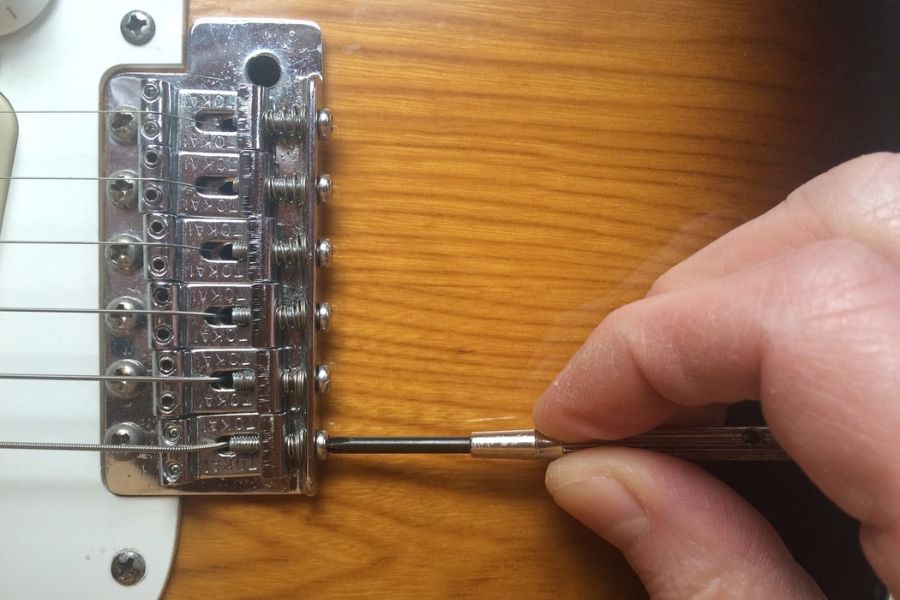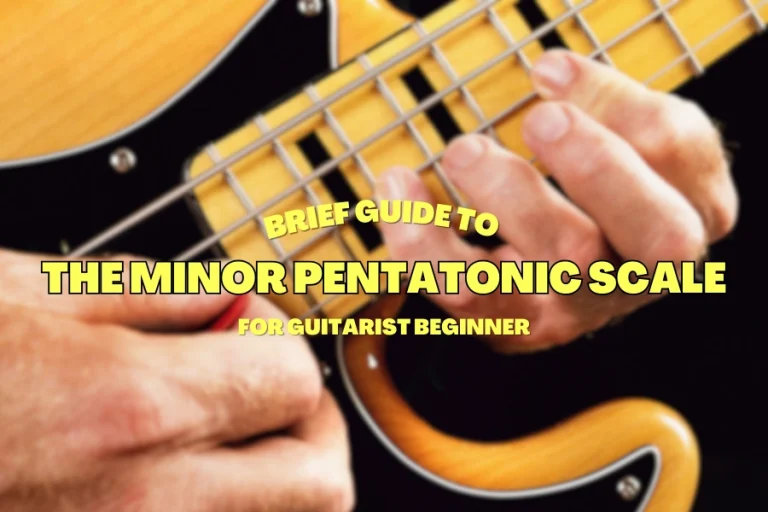When you play an electric guitar, you can really rock out with its clear, sharp sounds. To play the electric guitar well, it doesn’t matter what kind of music you like, every note needs to be just right. You need to make sure it’s tuned perfectly, especially on the pitch.
You need to keep its intonation in check whether you’re trying out new tunings, string types, or just strumming in your own way. This piece will help you learn how to intonate your electric guitar.
How To Adjust Intonation On An Electric Guitar?
Learning what is in there on the 12th fret is the key to getting the intonation of your guitar just right. You’ll understand why the 12th fret is so important and make sure you hit the mark every time you practice if you know how it works.

Harmonic Note and Fretted Note
Harmonics on Your Electric Guitar
A harmonic on an electric guitar is a note that when you lightly tap the guitar string at special spots, like the 12th, 7th, or 5th fret but don’t push it all the way down, usually it’s the 12th fret because it matches the open string’s note but sounds higher. Just give it a gentle touch and pluck the string, without pressing the string down to the fretboard.
And that way you’ve just made a cool, bell-like sound we call a harmonic, with a high-pitched voice, one octave up from its normal sound one octave up from its normal sound.
Playing Fretted Notes
Now, let’s talk about making regular notes, which we call fretted notes. Here, you press the string down hard against the fretboard at a spot, like the 12th fret, and then pluck it. It makes the string shorter from where you’re pressing down, changing how high or low the note sounds.
How To Adjust Intonation On An Electric Guitar?
For an electric guitar to be properly intonated, the pitch of the 12th fret harmonic and the fretted note at the 12th fret you get when you press down at the same spot must match exactly. This means the string’s length is perfectly adjusted for the guitar’s scale, and the instrument plays in tune across all frets.
If these two notes sound different, it’s a hint that your guitar is a bit out of tune in certain places. Here’s what you might notice:
- Sharp Fretted Note: If the fretted note at the 12th fret is sharper (higher in pitch) than the harmonic. You can fix this by moving the part where the string rests at the bottom of the guitar (we call this the bridge saddle) backward, away from the headstock. It’s like stretching the string a bit more to get the right notes.
- Flat Fretted Note: If the fretted note is flatter (lower in pitch) than the harmonic, the string is too long. This time, you can tighten the string by scooting the bridge saddle forward, toward the headstock making the string a bit shorter.

Electric guitars usually have separate bridge saddles for each string. This lets the tuning of each string be adjusted very precisely. Compared to some acoustic guitars that may have a fixed bridge saddle for all strings, this trait makes it easier to fine-tune the intonation.
You’ll need a tuner to see if the notes are matching because our ears might not catch the small differences.
And there you have it! Making these tweaks ensures your guitar’s voice is pitch-perfect all over the fretboard, making all your songs sound just as they should.
A Step by Step Guide To Intonate On Electric Guitar
Things You Will Need

To make sure your electric guitar is singing just right with perfect intonation, you’ll need a few handy tools and bits of gear. Here’s what you need to gather up before you start:
- Electronic Tuner: This is necessary to make sure each string is tuned just right. A clip-on tuner or a pedal tuner works great, but any reliable tuner will do the trick.
- Screwdriver: You’ll need one of these to adjust the bridge saddles. The type (Phillips or flathead) depends on your guitar’s bridge.
- Fresh Strings: It’s best to start with new strings that aren’t worn out. Old strings can be tricky and might not give you the true tune you’re looking for.
- Patience: Okay, it’s not something you can put in your toolkit, but you’ll definitely need a good dose of patience. Getting intonation just right might take a few tries.
Step-by-Step Guide for Electric Guitars:

Step 1: Tune each String: First up, grab your tuner and tune each string so it’s pitch-perfect.
Step 2: Check the 12th Fret Harmonic: On the 12th fret, lightly touch the string and pluck it. You’ll hear a cool, echo-y note. That’s your harmonic.
Step 3: Compare with the Fretted Note: Next, press down on the same fret and pluck. This note is your fretted note, and Check the pitch on your tuner. it should match your harmonic notes, if not, we will move to the next step.
Step 4: Adjust the Bridge Saddle:
- If the fretted note is sharp, extend the string by turning the bridge saddle adjustment screw back with a screwdriver.
- For flat fretted notes, turn the adjustment screw to shorten the string by moving the saddle forward.
Step 5: Retune and Recheck: After each tweak, tune up again. Make sure your harmonic and fretted notes on the 12th are in unison.
Step 6: Repeat for All Strings: Go through each string individually, one by one.
Other ways to Fix Electric Guitar Intonation
On an electric guitar, the main way to fix tuning is to change the string length at the bridge saddle. But there are a few other things and changes that can affect intonation that also need your attention for the best performance:

String Gauge
When you switch to a thicker gauge of strings, it means you’re choosing strings that are heavier and have a larger diameter than what you might have been using before.
Players that want more volume, sustain, and tone prefer thicker strings. Rock, metal, and blues sound fuller with heavier strings. However, they can be harder to play, especially for beginners or on lightning-fast sections, and cause greater guitar tension, affecting intonation due to the energy needed to fret notes precisely.
As you proceed up the neck with stronger strings, notes can sound harsher without proper intonation. This is because greater tension influences how much the string extends when fretted. And it may require you to move the bridge saddle back.
On the flip side, thinner strings are less tense. They pull less on the neck and bridge. Thinner strings can flatten tones up the neck without changes. Thinner strings may require a front bridge saddle. Thinner strings may require fewer intonation corrections due to less neck strain.
String Action

String action is how high your strings are from the fretboard. If your strings are way up high (we call this “high action”), you’ll have to push them down harder to play. This extra push stretches the strings more and can make your notes shout out sharper (a bit too high) than you want. High action affects intonation (changing the string’s pitch) more dramatically.
Your electric guitar has higher action for a lot of different reasons. One of them is that the weather might change the wood on your guitar neck. For example, the temperature and humidity can change a lot in the summer and winter. It changes how far your strings are from the frets if your neck moves too much or too little because of this.
Adjust the truss rod, which is like the spine of your guitar neck, to straighten the neck. It can also lower the action without making the strings too close to the frets (which would cause buzzing).
Intonation On Specific Electric Guitar Bridges
Each type of guitar has a slightly different intonation, especially when you look at the different bridge and saddle shapes that are needed for tuning. Different types of bridges on electric guitars mean that they need strategies that vary.

Floating Tremolo Bridges (like Floyd Rose)
These bridges let you make super precise changes. You can move each string’s saddle back and forth to get the pitch just right.
It’s all about keeping the string pulled and the spring push just right. This keeps your guitar sounding good and in tune.
These guitars have a special nut that locks down the strings. This helps keep your tuning steady. Just make sure it’s set up right.
Vintage-Style Tremolo Bridges (like on a Fender Stratocaster)
You can adjust each string’s saddle here too, just like the floating bridges. Loosen the string, tweak the saddle, and you’re good to go.
There’s a special claw in the back that holds the springs. You can tighten or loosen it to make the bridge sit just right. This helps your guitar stay in tune when you use the tremolo.
Fixed Bridges (like Gibson Tune-O-Matic)
These bridges don’t move, making them easier to deal with. You can still adjust the saddles to fine-tune each string.
Some bridges have special saddles that help make each string sound just perfect.
Conclusion
Regular checks and changes, which can be done at home or by a professional, are needed to keep good intonation.
It could mean making small changes to the bridge saddles to get the right string length, the truss rod to get the right neck relief, and the nut holes to make sure they are cut correctly for the strings being used.
Failure to address intonation problems can not only hurt your sound but also make playing less enjoyable.









